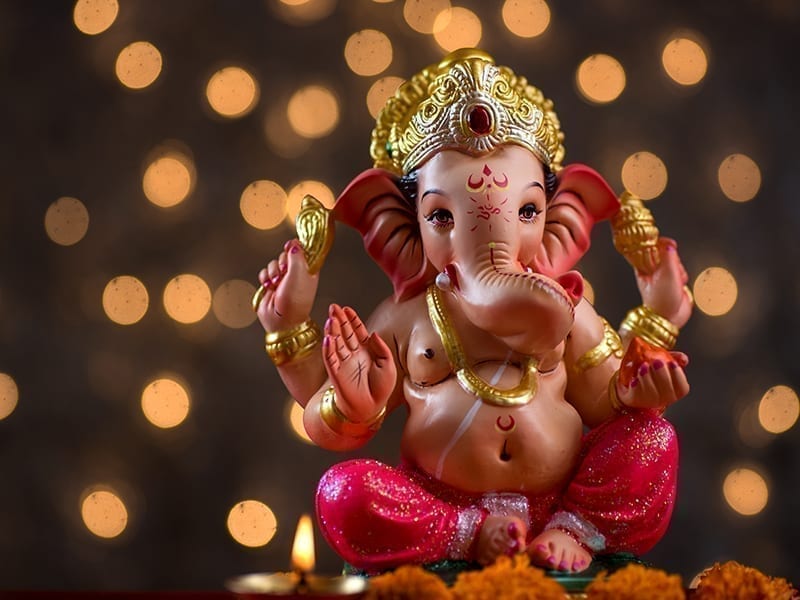Ganpati Bappa is coming to our homes again on the 22nd of August, 2020. But given the pandemic, this year the festivities will take a more sobering turn as the world continues to stay homebound because of Covid-19. So, what better way to celebrate than to whip up some classic Ganesh Chaturthi recipes in your home kitchen to celebrate Bappa this year?
It’s time to be festive with friends and family, and nothing makes for a great conversation than delicious food that everyone can enjoy and bond over.
Here are 8 recipes you can use this Ganesh Utsav, along with the recipe of the mandatory Panchamrut Prasad!
An Easy Take On Bappa’s Favourites
Many of your childhood memories are associated with Vinayaka Chaturthi, especially if you hail from Maharashtra, you’ve definitely been a part of this festival during your growing years. So, here’s an easy spin on yours and Bappa’s classic favourite foods!
1. Puran Poli
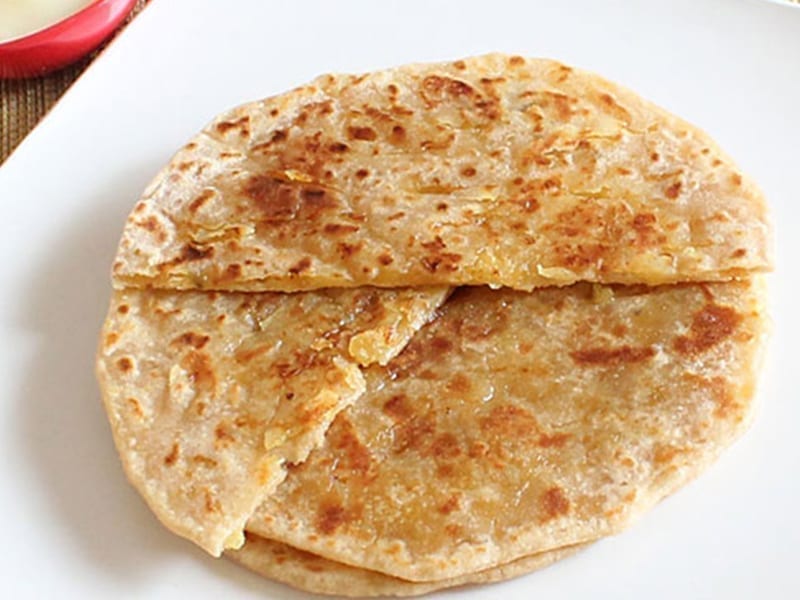
This Ganesh Chaturthi, make puran polis stuffed with love and care by following this easy recipe.
Nutritional Facts (Per Serving): Calories: 190 | Carbs: 30.8g | Protein: 4.6g | Fat: 6.3g | Fibre: 3.1g
Preparation Time: 4 hours
Cooking Time: 30 minutes
Servings: 6
Ingredients:
For The Sweet Stuffing:
- 1 cup powdered jaggery
- 1 cup Bengal split gram (chana dal)
- 3 cups water
- 2 teaspoon ghee
- 1 teaspoon fennel powder (saunf)
- 1 teaspoon dry ginger powder
- 4 to 5 cardamom (elaichi) crushed finely
- ¼ teaspoon nutmeg (jaiphal) powder
For The Poli (Outer Covering):
- 2 cups of whole wheat flour (atta)
- 4 tablespoons of oil or ghee
- ½ teaspoon salt
- ¼ teaspoon of turmeric (haldi) powder
- Water (as needed to knead the dough)
- Oil (as needed for frying the polis)
Method:
- To prepare the puran, rinse the chana dal and soak it in water for 30 minutes. In a pressure cooker, cook the chana dal for about 5 to 6 whistles. Strain the dal once it’s cooked and keep the stock since you can reuse it in any vegetable curry or any thin tempered dal.
- Heat ghee in a pan and add the dry ginger powder, jaiphal powder, elaichi, and saunf powder. Fry them for a few seconds and then add the chana dal and the jaggery.
- Stir this mixture on a low flame till it’s entirely cooked. Once the puran becomes dry and thick, switch off the flame. Mash it well with your hands or a potato masher when it cools down.
- Meanwhile, prepare the dough for the polis. Mix the dry ingredients in a bowl and knead it with water and oil. The dough should be soft and plump. Let it rest for about 15-20 minutes.
- On a dusted rolling board, take a medium to large-sized dough ball and roll it out. Place a portion of the puran mixture in the centre. Next, bring the edges together and join them to form a ball.
- Sprinkle some flour and roll the dough ball again. On a heated tawa, add some ghee and place the rolled flour on it. Once the one side becomes brown, turn over to the other side and cook it till brown spots appear again.
- Cook all the puran polis this way and serve it with some dahi (yoghurt), milk or ghee at room temperature!
2. Coconut Ladoo
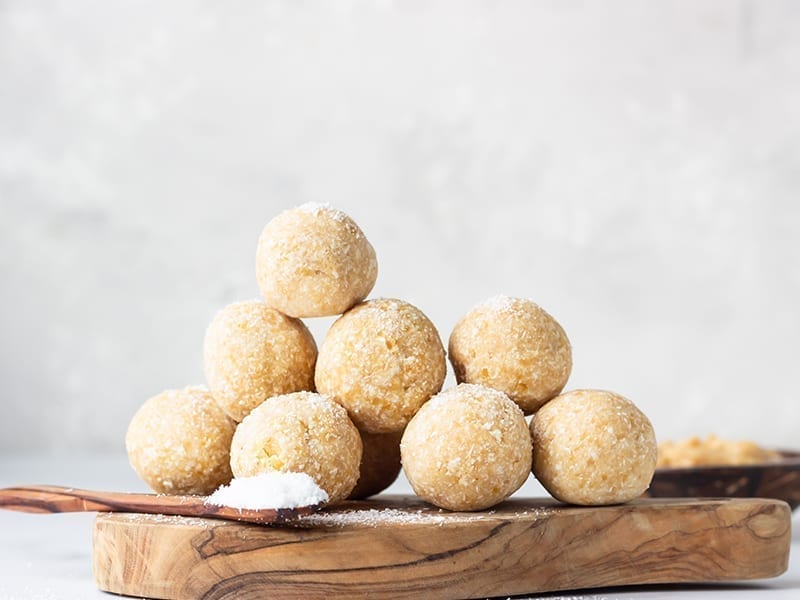
These melt-in-your-mouth ladoos are made with desiccated coconut; they’re both flavourful and fragrant.
Nutritional Facts (Per Serving): Calories: 132 | Carbs: 16.1g | Protein: 1g | Fat: 7.1g | Fibre: 1.1g | Sugar: 3.5g
Preparation Time: There’s no prep needed. Just gather the ingredients!
Cooking Time: 15 minutes
Servings: 14
Ingredients:
- ½ cup of desiccated coconut for rolling
- 1 teaspoon ghee
- ½ teaspoon elaichi powder
- ½ tin of sweetened condensed milk
- 1.5 cups of freshly grated coconut
- Chopped dry fruits (optional)
Method:
- Heat 1 teaspoon of oil in a frying pan and add the freshly grated coconut. Stir and fry this coconut on a low flame for about 3-4 minutes. Don’t brown them but just remove the moisture.
- Now add the condensed milk to it. Once it heats up, add the elaichi powder. Keep stirring on a low flame until the mixture starts to thicken.
- When you see some of the coconut fats from the sides, switch off the flame. Once it completely cools down, pinch medium-sized balls out of the mixture. Make the ladoos and roll it in desiccated coconut.
- Your coconut ladoos are ready! Store them in the refrigerator in an airtight container for 4-5 days or serve them straight away.
3. Kala Vatana Sambar
This bean curry is often given to Ganpati Bappa as prasad during the Chaturthi. It’s an authentic Malvani dish that can be made at home for lunch.
Nutritional Facts (Per Serving): Calories: 174 | Carbs: 19.5g | Protein: 6g | Fat: 8g | Fibre: 1.8g | Sugar: 1g
Preparation Time: 9 hours
Cooking Time: 45 minutes
Servings: 4
Ingredients:
- 1.5 cups of black beans
- 1 large onion (chopped)
- 1 tomato
- 2 cups grated coconut
- 2 dried red chillies
- 1 inch ginger (adrak)
- 5-6 cloves of chopped garlic
- 1.5 tablespoon of Malvani masala
- ½ teaspoon turmeric (haldi)
- Few coriander sprigs (dhaniya) for garnishing
- Oil for frying
- Water (as needed)
- Salt (as per taste)
Method:
- The process needs to be started from the previous night itself. Wash the black beans and soak it in for 8 hours. The next day, discard the water from the beans and boil them with salt and three cups of water in the pressure cooker for about 12 minutes. Drain and keep the broth.
- Now on a tawa heat up 1 tablespoon of oil and fry the onions until light brown. Add the chopped garlic and ginger and fry for about a minute.
- This is when you’ll add the grated coconut and red chillies till everything is well cooked. Once this masala mixture cools down, add this to a mixer grinder along with the black beans and water and grind it to a smooth paste.
- In another pan, take 1 tablespoon of oil and fry the rest of the onions until translucent. Now add the Malvani masala and haldi powder to it.
- Add the smooth bean paste, the rest of the masalas and everything together and fry it. You don’t need to fry for a longer period of time since the masala has been cooked previously.
- Add the broth from the beans and 2 and ½ cups of water and bring to a rolling boil. Simmer for about 15 minutes and cook on low flame. You can adjust the consistency of the sambhar as per your choice. Make sure to check your seasoning before you serve it. Serve the kala vatana sambar hot or with puris!
4. Besan Ke Ladoo
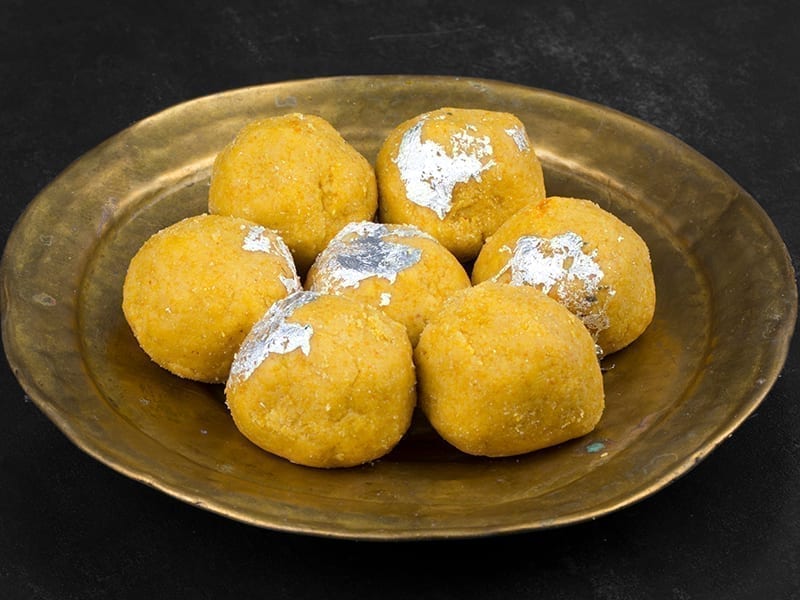
Made from gram flour, clarified butter and powdered sugar, besan ke ladoo never fails to impress relatives, neighbours, friends and family during festival season.
Nutritional Facts (Per Serving): Calories: 307 | Carbs: 38.1g | Protein: 8g | Fat: 13.6g | Fibre: 5.6g | Sugar: 4.9g
Preparation Time: 5 minutes
Cooking Time: 20 minutes
Servings: 15
Ingredients:
- 2 cups chickpea flour (besan)
- ½ to ¾ cup of ghee
- 1 cup powdered sugar
- 4 elaichi, crushed and powdered
- 1 or 2 raisins
Method:
- Dry roast the besan on a pan for about 11-12 minutes. Make sure to not burn the besan so keep stirring continuously until it’s evenly golden.
- Melt the ghee and keep aside. After roasting the besan, add the ghee and continue cooking for 5-6 minutes more. It would release a nice nutty aroma.
- Once a nice and strong nutty fragrance releases the pan, switch off the flame. Add the powdered sugar and make sure it’s well incorporated and no lumps are present.
- Add the elaichi and raisins. Additionally, you can also add dried nuts to it.
- Once the entire ladoo mixture is mixed and cooled, make medium-sized balls out of the mixture and store them in an airtight container.
5. The Classic Modak
Ganesh Chaturthi is absolutely incomplete without modaks. Here is a steamed modak recipe which is also known as ukdiche modak. Try it out this Ganesh Puja and let us know how it turned out.
Nutritional Facts (Per Serving): Calories: 126 | Carbs: 20.1g | Protein: 1.2g | Fat: 4.4g | Fibre: 1.6g | Sugar: 2.8g
Preparation Time: 10 minutes
Cooking Time: 40 minutes
Servings: 5
Ingredients:
- 1 cup of grated coconut
- 1 cup jaggery
- 1 pinch of jaiphal
- A pinch of saffron (kesar)
- 1 cup water
- 2 tablespoons of ghee
- 1 cup rice flour
Method:
- In a pan, add the coconut and the jaggery together. Stir together for 5 minutes and then proceed with the kesar and jaiphal. Cook for another 5 minutes and keep aside.
- In another deep dish, boil water and ghee. Add the salt and flour and mix well.
- After spreading some ghee to the base of a steel bowl, add the dough and knead it while it’s hot.
- Now take a little dough, roll it into a ball, flatten it and shape the edges in a flower pattern. Put the filling of coconut and jaggery inside and seal it. Prepare all the modaks this way and then put it into a steamer for about 10-15 minutes.
- Your steamed modaks are ready to be served!
6. Rice Payasam
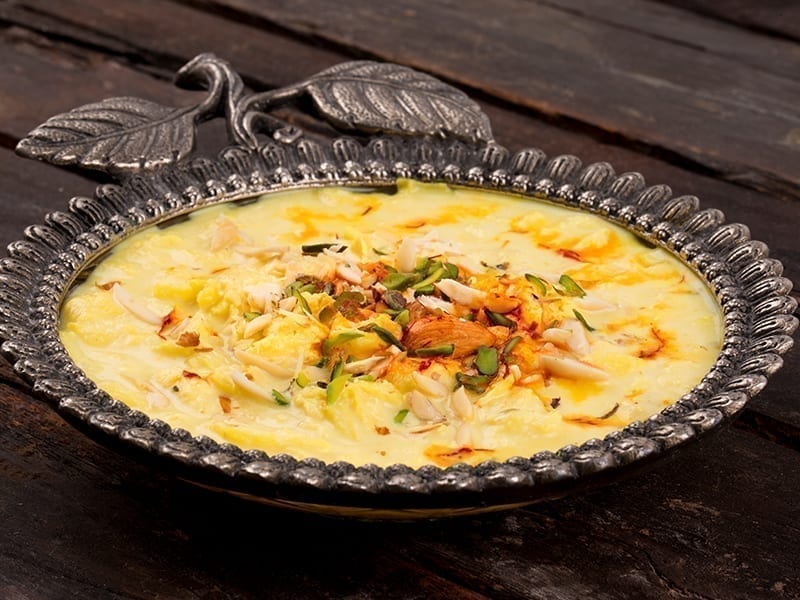
Made with coconut milk and jaggery, this recipe is not only a hit during Ganesh Puja but also during Dussehra. The best part of this recipe is the fact that it is vegan and diabetes-friendly!
Nutritional Facts (Per Serving): Calories: 235| Carbs: 30.6g | Protein: 5.9g | Fat: 8.1g | Fibre: 0.5g | Sugar: 4.2g
Preparation Time: 20 minutes
Cooking Time: 20 minutes
Servings: 2-3
Ingredients:
- 1 cup rice
- 2-3 turmeric leaves
- 2 cups thick coconut milk
- ½ teaspoon elaichi powder
- 2 cups of stevia or a sweetener of your choice
- 1 pinch of jaiphal powder
- 2 tablespoons of coconut oil
- 10-12 cashews (kaju badam)
Method:
- Rinse the rice well and add it in a pressure cooker with 3 cups of coconut milk. Also, make a knot of the turmeric leaves and add it in the pressure cooker.
- Cook in the pressure cooker until the rice is soft and done.
- Now add the stevia to the cooked rice. Mix well and add the thick coconut milk to it. Cook this entire mixture on a low flame for 3 minutes.
- In another small pan, heat oil and fry the kaju badams. Add the elaichi and jaiphal powder to the pan where the cashews are being fried.
- Stir and pour in the cashews in the payasam mixture. Mix well and serve your rice payasam either hot or cold!
7. Rishi Panchami Sabzi
Rishi Panchami is celebrated on the second day of Ganesh Chaturthi where the sapta rishi or the seven sages are invoked and worshipped. This dish usually contains a mix of veggies often using seasonal tubers.
Nutritional Facts (Per Serving): Calories: 258| Carbs: 23 g | Protein: 4g | Fat: 17g | Fibre: 3.9g | Sugar: 2.5g
Preparation Time: 25 minutes
Cooking Time: 30 minutes
Servings: 6
Ingredients:
- 1 teaspoon tamarind (imli)
- ¼ cup of hot water
- 3 tablespoon of ghee
- 2 chopped green chillies
- 700 grams of mixed veggies (the veggies that can be used include: ridge gourd (turai), yellow pumpkin (kaddu), yam (suran), plantain (kacche kele), red amaranth (chaulai), amaranth stems (chaulai ke danthal), colocasia (arbi), colocasia leaves (arbi ke patte), corn cob (makai), and so on.
- ½ cup fresh peanuts
- 1 tablespoon jaggery
- 2 cups of water
- Salt, as per taste
Method:
- In a small bowl, take the tamarind pulp and soak it in for 20 minutes in hot water. Later squeeze the pulp and keep the tamarind aside.
- Rinse and peel all the vegetables that you’re using properly while the tamarind is soaking. Chop each of the veggies in squares or cubes. If using makai, then you can scrape off the kernels from the cob.
- Heat three tablespoons of oil in a large pan. Add the green chillies and fry them for a bit. Add the remaining chopped veggies and tubers to it. Mix well and fry them for about 3-4 minutes on low flame.
- Add the peanuts and 2 cups of water to it. Season with salt and simmer the veggies on a low flame for about 5 minutes.
- You need to keep checking the veggies to make sure that they are cooked properly. Once they are nearly done, add the tamarind pulp to it and 1 cup of freshly grated coconut. Your Rishi Panchami Sabzi is done!
8. Panchamrut Prasad
A traditional recipe used in Hindu religious festivals, panchamrut prasad is made using 5 ingredients, as the name suggests. A classic during Ganesh Chaturthi, it is by far the easiest to prepare. Also, check out 8 additional authentic ganpati prasad recipes here.
Nutritional Facts (Per Cup): Calories: 286| Carbs: 23.7 g | Protein: 7.6g | Fat: 13.9g | Fibre: 0.1g | Sugar: 3.5g
Preparation Time: 5 minutes
Cooking Time: 5 minutes
Servings: 6
Ingredients:
- ½ litre raw cow’s milk
- 200 g cow’s milk curd (dahi)
- 3 tablespoon honey
- 10-12 basil (tulsi) leaves
- 1 teaspoon ghee
- 10-12 phool makhana (cut into small pieces)
- 1 teaspoon chironji
- 1 teaspoon ganga jal
- 1 tablespoon almonds (chopped)
- 1 tablespoon kaju badams (chopped)
- 1 tablespoon dry coconut (grated)
- 1 tablespoon raisins (chopped)
Method:
All you have to do to prepare panchamrut prasad is to mix all the ingredients together and you’re done. You can either refrigerate it or serve it as it is.
Happy Ganesh Chaturthi from Team TC46. We hope Bappa brings love and light in your homes. Do let us know how the recipes turned out! Try these unique gauri ganpati decoration you can easily make at home and brighten the environment.

